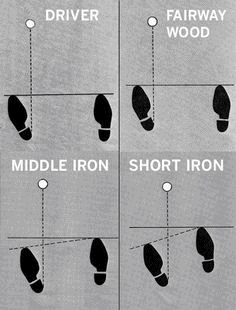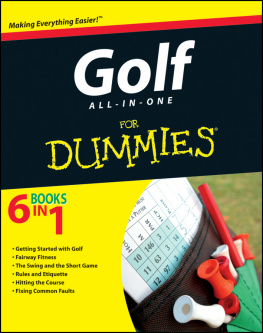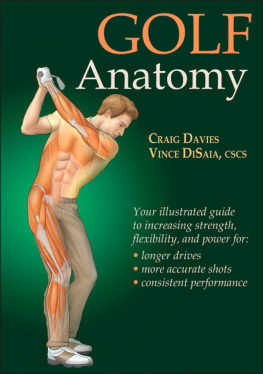All rights reserved.
The author and publisher have provided this e-book to you for your personal use only. You may not make this e-book publicly available in any way. Copyright infringement is against the law. If you believe the copy of this e-book you are reading infringes on the author's copyright, please notify the publisher at: https://us.macmillan.com/piracy
Principles You Must Understand
1. The Two Most Important Concepts of the Golf Swing
Generally, it's easy to find excellent instructions out there. But they hardly ever extend to the key reasons for the flaws in your game. During your one-hour training session, your instructor will probably correct some flaws and send you on your way. After a week, you will probably have forgotten about those fixes and revert back to your old techniques.

Do you know why? It's mainly because you are not getting the concepts to support your understanding of what's being taught. You're just getting band-aid fixes. The moment you discover the concepts regarding your golf swing, you'll be able to fully grasp your technique and become a better golfer.
You will find that there are three lines you must become familiar with, the target line (the line that you want the ball to finish on), the swing path line (path of your swing), and the clubface direction line (where the face of the club is pointing at impact). The latter two are important concepts you must understand and have control of in order to play better golf.

Clubface direction is the line where the ball will start moving on. The relationship between the clubface direction and the swing path determines just how much spin your ball will have, which determines how much the shot will curve. If you're able to understand this, you can actually correct your swing and even make improvements without needing to take lessons.
To take control of your ball flight, you must learn how to control your clubface direction and also your swing path.

2. Understanding Your Ball Flight
With the help of modern technology, it has been determined that the clubface direction is the key influencer of the initial direction of the golf ball. Additionally, your swing path determines how much curve or spin is put on the golf ball.

There are three different kinds of clubface at impact:
- Pointing in the same direction as the swing path (we refer to this as square).
- Pointing to the right of the swing path (we refer to this as open).
- Pointing to the left of the swing path (we refer to this as closed).
Results have demonstrated that upwards of 80% of your initial ball flight direction is determined by the clubface direction and the other 15%20% is influenced by the relationship between the clubface direction and swing path.

For example, have you noticed someone slice the ball and they're advised to aim more to the left? This fundamentally shifts the swing path and can result in the clubface direction to become much more open. As a result, you have a path that's traveling much more to the left and a clubface that is directed more to the right of the path (open).

A common sight with beginners is seeing their ball flight start off to the left and have a large curve off to the right (the banana slice ). This leads to much more slice, more distance lost, and more accuracy lost. You'll be missing the boat by simply altering your swing path to correct this problem. This is because only about 15%20% of the golf ball direction is affected by the swing path.
If you wish to hit it straight, the face of the club needs to point along the swing path. Using this knowledge, you can control your own swing and your golf game improvement. You can easily make on the spot corrections, just as the good players do.

The next time you play a round or visit the driving range, pay attention to your flight. It can provide lots of feedback about your clubface direction and your swing path.
3. Pre-Shot Routine
You will find lots of golfers that just step up to their shot and hit it. There is absolutely no thought of how far to hit the shot, where to hit the shot, or what ball flight to use.
You'll need a checklist before you hit the next shot. The majority of golf courses provide you with information about each hole. It may be on the scorecard, near the tee box, or on a yardage book.
Every hole was developed with a pre-determined approach to play it for optimum proficiency. Some courses also provide you with the ideal shot pattern as imagined by the course designer.
This is certainly good and useful information on the best ways to play the hole.

Together with the introduction of global positioning systems (GPS), range finders, and smartphone apps, you've got a lot of this valuable information at your fingertips. Many of these devices will provide you with the distance to hazards, the distance to the 150 marker, and the distance from your landing area to the front, center, and back of the green. With all this information, you simply have to select which club can get you to the landing area and execute the shot.
Developing a pre-shot routine will help you get rid of some of the mental mistakes that can cost you strokes throughout the round.
There should be five parts to your routine, which should be performed with every shot.

Examine the surroundings: Take note of the wind, your lie, and your stance.
Pick out a target: Exactly where would you like the ball to land? How far is it to the target/landing area? Where are the hazards (should you play away from the hazards)? If the fairway is a target, how far is it to the widest part? Which side do you wish to be on? If hitting into the green, which area do I want to land on? Where can I miss and still have a chance to get up and down?
Visualize the Shot: See the shot in your mind.
Take Practice Swings: Take a few practice swings to get a feel for the shot and the shot shape. It's like programming it into your subconscious.

Pick an intermediate target and make a good swing: Pick a target a few feet away, an imperfection, a clump of grass, or something on the ground. This will be used as your swing path guide as you will swing over this line.


















